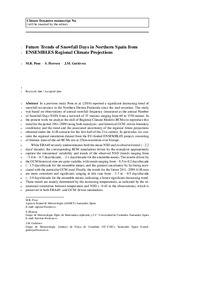Por favor, use este identificador para citar o enlazar este ítem:
http://hdl.handle.net/20.500.11765/1344
Future trends of snowfall days in northern Spain from ENSEMBLES regional climate projections
Registro completo de metadatos
| Campo DC | Valor | Lengua/Idioma |
|---|---|---|
| dc.contributor.author | Pons Reynés, María Rosa | es_ES |
| dc.contributor.author | Herrera García, Sixto | es_ES |
| dc.contributor.author | Gutiérrez Llorente, José Manuel | es_ES |
| dc.date.accessioned | 2016-03-17T15:38:25Z | - |
| dc.date.available | 2016-03-17T15:38:25Z | - |
| dc.date.issued | 2015 | - |
| dc.identifier.citation | Climate Dynamics. 2015 | es_ES |
| dc.identifier.issn | 0930-7575 | - |
| dc.identifier.issn | 1432-0894 | - |
| dc.identifier.uri | http://hdl.handle.net/20.500.11765/1344 | - |
| dc.description.abstract | In the present work we analyze the skill of Regional Climate Models (RCMs) to reproduce this trend for the period 1961–2000 (using both reanalysis- and historical GCMdriven boundary conditions) and the trend and the associated uncertainty of the regional future projections obtained under the A1B scenario for the first half of the twenty-first century. In particular, we consider the regional simulation dataset from the EU-funded ENSEMBLES project, consisting of thirteen state-of-the-art RCMs run at 25 km resolution over Europe. While ERA40 severely underestimates both the mean NSD and its observed trend (−2.2 days/ decade), the corresponding RCM simulations driven by the reanalysis appropriately capture the interannual variability and trends of the observed NSD (trends ranging from −3.4 to −0.7, −2.1 days/decade for the ensemble mean). The results driven by the GCM historical runs are quite variable, with trends ranging from −8.5 to 0.2 days/decade (−1.5 days/decade for the ensemble mean), and the greatest uncertainty by far being associated with the particular GCM used. Finally, the trends for the future 2011–2050 A1B runs are more consistent and significant, ranging in this case from −3.7 to −0.5 days/decade (−2.0 days/decade for the ensemble mean), indicating a future significant decreasing trend. These trends are mainly determined by the increasing temperatures, as indicated by the interannual correlation between temperature and NSD (−0.63 in the observations), which is preserved in both ERA40- and GCM-driven simulations. | es_ES |
| dc.description.sponsorship | This research has received funding from the European Union’s Seventh Framework Programme under grant agreements 606799 (INTACT Project). The RCM simulations used in this study were obtained from the European Union-funded FP6 Integrated Project ENSEMBLES (Contract number 505539). | - |
| dc.format | application/pdf | - |
| dc.language.iso | eng | es_ES |
| dc.publisher | Springer | es_ES |
| dc.rights | Licencia CC: Reconocimiento–NoComercial–SinObraDerivada CC BY-NC-ND | es_ES |
| dc.subject | Dynamical downscaling | es_ES |
| dc.subject | Regional climate modeling | es_ES |
| dc.subject | Snowfall occurrence | es_ES |
| dc.subject | Snowfall trends | es_ES |
| dc.subject | Nieve | es_ES |
| dc.subject | Modelos climáticos | es_ES |
| dc.subject | Frecuencia de las precipitaciones | es_ES |
| dc.title | Future trends of snowfall days in northern Spain from ENSEMBLES regional climate projections | es_ES |
| dc.type | info:eu-repo/semantics/article | es_ES |
| dc.relation.publisherversion | https://dx.doi.org/10.1007/s00382-015-2793-9 | es_ES |
| dc.rights.accessRights | info:eu-repo/semantics/openAccess | es_ES |
| dc.relation.projectID | info:eu-repo/grantAgreement/EC/FP7/606799 | - |
| dc.relation.projectID | info:eu-repo/grantAgreement/EC/FP6/505539 | - |
| Colecciones: | Artículos científicos 2015-2018 | |
Ficheros en este ítem:
| Fichero | Descripción | Tamaño | Formato | ||
|---|---|---|---|---|---|
| 2015_Pons_CD_Snow_pp.pdf | 14,78 MB | Adobe PDF |  Visualizar/Abrir |
Los ítems de Arcimis están protegidos por una Licencia Creative Commons, salvo que se indique lo contrario.





